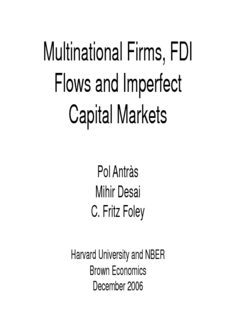
Multinational Firms, FDI Flows and Imperfect Capital Markets PDF
Preview Multinational Firms, FDI Flows and Imperfect Capital Markets
Multinational Firms, FDI Flows and Imperfect Capital Markets Pol Antràs Mihir Desai C. Fritz Foley Harvard University and NBER Brown Economics December 2006 Motivation (1) Great interest in contracting environments influence on financing and investment patterns Exclusive theoretical and empirical emphasis on firms that are presumed to be entirely local – raising money locally, operating locally. Contradicts reality of high levels of global integration - eg. shares of profits/investment from abroad for developed country firms and reliance of institutionally fragile economies on FDI Motivation (2) Two distinct literatures on MNCs and FDI that emphasize either capital flows or patterns of firm activity - Macro literature on financial flows asks why more capital does not flow to emerging markets - IO and International Trade literature on MNC activity emphasizes the role of proprietary assets to explain where firms base activity •To our knowledge, there is no integrated explanation of how MNC operational and financial decisions are linked •Recent studies suggests that credit market imperfections and other institutional features play a role in shaping capital flows Question and Approach How are FDI flows and MNC firm activity interrelated? Particularly, in a world with frictions in financial contracting and variations in capital market development? • A model of how firms jointly make operating, financial & investment decisions in a setting where financial frictions play a central role - Follow Holmstrom and Tirole (1998)’s moral hazard approach to modelling financial frictions; monitoring helps alleviate financial frictions. • Key Idea: Inventors (MNC firms) wanting to deploy technology abroad have comparative advantage in monitoring its use relative to other funders (i.e, external investors) - Consistent with managerial literature -Dunning (1970) notes that MNCs provide “informal managerial or technical guidance,…the dissemination of valuable knowledge and/or entrepreneurship in the form of research and development, production technology, marketing skills, managerial expertise, and so on...” Findings (1) The optimal exploitation of the technology in a foreign country will generally be associated with monitoring by the “inventor” (or parent firm) When is monitoring associated with equity participation? • Not when monitoring is verifiable - then, inventor provides technology and monitoring without investing and simply receives licensing fees • When monitoring is nonverifiable, optimal contract stipulates that inventor takes a stake in the project to ensure an incentive to monitor; in addition, the inventor may be required to cofinance the investment (through FDI flows) • External investors demand equity participation and cofinancing by inventor to induce monitoring Mechanism generating MNC activity is not risk of expropriation of technology by a local partner but the demands of external investors who want to maximize the value of their investment Findings (2) Empirical predictions of model receive support in tests using detailed firm-level BEA data that permit inclusion of parent-year f.e.’s -FDI vs. Licensing: firms are more likely to exploit technologies through licensing in countries with stronger investor protections - Financing: share of affiliate assets financed by parent is a decreasing function of investor protections –these effects are more pronounced for technology intensive firms - Ownership: share of affiliate equity owned by the parent is a decreasing function of investor protections – again, these effects are more pronounced for technology intensive firms - Scale of activity: liberalizations of ownership restrictions have larger effects in countries with poorly developed capital markets Agenda Literature Review Describe model and theoretical findings Intuition behind empirical predictions Empirical approach and results Conclusions and Further Directions Brief Literature Review (1) Large, growing literature on quality of contracting institutions and firm financing and investment decisions – results on market capitalization, ownership structures, and industrial structures This literature all abstracts entirely from firm activity across borders Some attention to cross-listing decisions and contracting institutions but no notion of cross-border activity by firms…Gertler & Rogoff (1990), Boyd and Smith (1997) and Shleifer and Wolfenzon (2004) take first steps by introducing open economy setting with heterogeneity in contracting institutions Brief Literature Review (2) Two very distinct literatures on flows and MNC activity Macroeconomic literature on capital flows Lucas (1990) Paradox: why capital does not flow to poor countries given large presumed rate of return differentials => human-capital externalities; Reinhart and Rogoff (2004), Alfaro et al (2004) point to credit markets and political risk IO and international trade literature on patterns of activity– Discuss patterns of MNC activity emphasizing transportation costs, EOS & proprietary assets Horizontal FDI – Transport costs and tariffs lead to local production Vertical FDI – Fragmented production worldwide to take advantage of relative advantages No unification of explanations of flows and activity Model: The Inventor Home Country Inventor Endowed with technology to produce differentiated good and with wealth W Preferences and technology at Home such that inventor earns gross return > 1 for each unit invested there Good is prohibitively costly to trade—use horizontal type investment in Foreign Needs to find local agent (referred to as foreign entrepreneur)
Description: